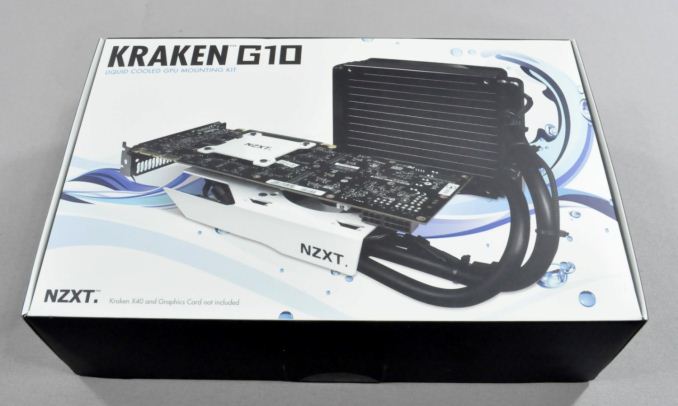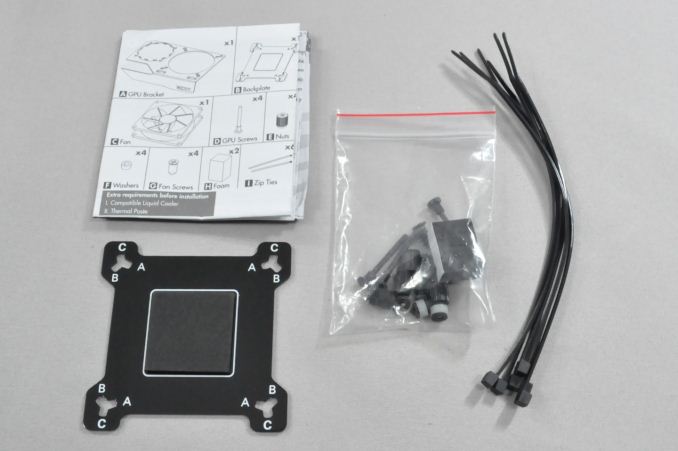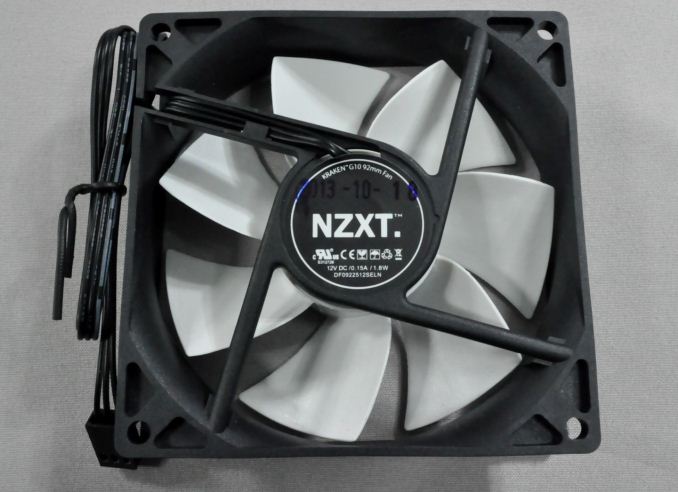NZXT Kraken G10 Review: Liquid Cooling for Your GPU
by E. Fylladitakis on March 11, 2014 1:15 AM EST- Posted in
- Cases/Cooling/PSUs
- NZXT
- Water Cooling
- Kraken
- G10

Introduction
Liquid-cooling is nothing new in the world of computers; enthusiasts first started creating custom water cooling setups back in the 80486 era, and even prior to that some mainframes used liquid-cooling. Due to their cost and complexity however, such cooling solutions often do not appeal to a large portion of users. With the advent of of closed loop, ready-to-run liquid-cooling kits from Asetek and CoolIT a few years back, however, liquid-cooling is now significantly less costly and complex. Today, the cooling solutions of both these two OEMs are being marketed by several brands and are becoming increasingly popular among all classes of users.
Despite the low cost and ease of installation however, these closed loop systems entirely lack the one thing that a custom liquid-cooling solution has: versatility. All of the closed loop liquid-cooling kits currently available in the market are designed be installed on a single CPU, without the possibility of any expansion, whereas custom setups could potentially cool all of the critical components in a system. Until recently, those who purchased any closed loop liquid-cooling kit were limited to cooling their CPU only, leaving their high-end graphics cards running on air. NZXT came up with a very simple and effective solution to this problem: a metallic bracket called the Kraken G10 that allows the installation of any Asetek-based liquid-cooling kit on most modern graphics cards. The compatibility list, as provided by NZXT, is as follows:
| GPU Compatibility |
Nvidia: GTX 780 Ti, 780, 770, 760, Titan, 680, 670, 660Ti, 660, 580, 570, 560Ti, 560, 560SE AMD: R9 290X, 290, 280X*, 280*, 270X, 270 HD7970*, 7950*, 7870, 7850, 6970, 6950, 6870, 6850, 6790, 6770, 5870, 5850, 5830 The compatibility list is based on AMD's Radeon and NVIDIA's GeForce reference board layouts, screw spacing, and die height only. Please check the height restriction before purchase. * Some variations in AMD die height may require the use of a shim. |
| Liquid-cooling kit compatibility |
NZXT: Kraken X60, Kraken X40 Corsair: H110, H90, H75, H55 , H50 Antec: KUHLER H2O 920V4, KUHLER H2O 620V4, KUHLER H2O 920, KUHLER H2O 620 Thermaltake: Water 3.0 Extreme, Water 3.0 Pro, Water 3.0 Performer, Water 2.0 Extreme, Water 2.0 Pro, Water 2.0 Performer Zalman: LQ-320, LQ-315, LQ-310 |
Packaging and bundled items
NZXT ships the Kraken G10 in a well-designed cardboard box, displaying their Kraken X40 liquid-cooler installed on a graphics card with the help of the bracket. Inside the box we find a leaflet with installation instructions, the hardware required for the installation of the bracket, and a few cable ties.
NZXT also supplies a 92mm fan, which can be installed on the Kraken G10 in order to cool the VRM and RAM chips of the graphics card. Such parts are inherently cooled by the stock cooler of the card, but as that will be removed and the liquid block only cools GPU core, the fan is a useful addition. The white-bladed fan comes from Martech and is a sleeve bearing, 2000RPM model.













61 Comments
View All Comments
owan - Tuesday, March 11, 2014 - link
The increase in fluid is only a cooling benefit until the system comes to equilibrium, at which point it becomes meaninglessmpdugas - Friday, March 14, 2014 - link
Of course, the CPU/GPU temperature is rarely at a steady, equilibrium state...Aikouka - Tuesday, March 11, 2014 - link
Before I built my first custom loop, I did a bunch of research into parts and such. One of the first things I stumbled across was a two facts about water cooling. (1) After a certain point, you don't gain much from increasing the flow rate. (2) It takes a large amount of coolant for the sheer volume to have a tangible effect on temperatures.The usual rule of thumb in water cooling is to use a LITTLE hose as possible. In *most* implementations, hoses are not designed to disperse heat unlike other items in the loop. So, unless you're one of those crazy types that uses copper tubing in their water cooling build, there isn't much of a point to excess tubing. Also, excess tubing can be just about as bad as too little tubing in that you can end up with some awkward bends. In my experience with AIOs, they aren't exactly known for using great clamping methods on the tubes. I recall reading complaints about leaks, and the users in questions had very tight bends, which I could see causing gaps between the rubber tubes and the barbs.
1Angelreloaded - Tuesday, March 11, 2014 - link
OK you are right, but wrong as well, see the pump supplies so much pressure per foot of available volumetric area, when we talk about pumps we typically discuss a statistic called pump head for that reason, you typically don't want 2 much head for a small loop otherwise the Bar pressure levels will be 2 high and most likely you will have leaks for most acrylic res containers, now if the head is 2 low you will have little pressure within the system and a low flow rate which is bad for a CPU cooler block that work better under a higher volume rate, 2 slow and the fluid will boil causing gas within the lines and catastrophe. GPU cooling is entirely different and because the Blocks are of a larger displacement they function better under lower pressure levels. Now how this would apply to an All in One cooler is beyond me but remember the original design is for a CPU not a GPU, a CPU can hover between 30-50 cel while a gpu can climb all the way to 90 cel, so I am not sure how I feel about this, My question would be more can This fit an EVGA 760 ACX SC 4GB and will it work with Corsair's Link software if it will an SLI 350D would be an interesting prospect.tim851 - Tuesday, March 11, 2014 - link
"One such limitation is that the fans of the liquid-cooling kit cannot be thermally controlled in relation to the temperatures of the graphics card."1) There is software, which can control fans and read GPU temps, like SpeedFan (at least for nVidia GPUs, last time I checked three years ago).
2) There are adapter cables, which let you connect a standard 3-pin fan to the 2-pin mini connector of a graphics card.
Yungbenny911 - Tuesday, March 11, 2014 - link
Or you can just get a fan controller for 20$. I have my 4 corsair fans in push pull config, and they are all controlled by my 600t's fan controller. MSI Afterburner's OSD is used to monitor the temp of the GPU as i am gaming, so i know when to ramp up the fans, or reduce them.E.Fyll - Tuesday, March 11, 2014 - link
1. The fan of the kit are not connected on the GPU, therefore they cannot be controlled by any such software. If the motherboard supports fan control on the header the fans may be attached to, then the speed of the fans may be controlled, which control will however be unrelated to the temperatures of the card.2. Yes, there are. These however are a) not included and b) the high amp draw of a 140 mm fan can easily fry the circuit of a card that was designed to drive fans 1/3 of that size. :)
thewhat - Tuesday, March 11, 2014 - link
"If the motherboard supports fan control on the header the fans may be attached to, then the speed of the fans may be controlled, which control will however be unrelated to the temperatures of the card."SpeedFan lets you automate the speed of any fan* based on any temperature in the PC (CPU, GPU, chipset, HDD,...).
*with the possible exception of the fans on Nvidia cards. AFAIK for now it only lets you read the temps, but not control the fan speed on the video card itself. With AMD cards, you can do both.
Aikouka - Tuesday, March 11, 2014 - link
Aren't some GPU fans around 80-90mm? I believe my Gigabyte Windforce card uses 75mm fans, but that's also three fans compared to just one 140mm.Nirvanaosc - Tuesday, March 11, 2014 - link
SpeedFan for the win! (if you use Windows)I use it and it's even better than letting the card control the fans because you can customize the